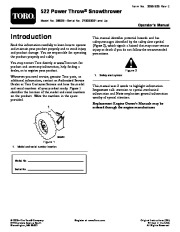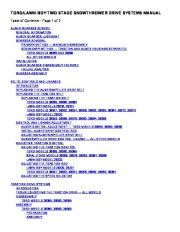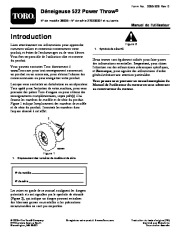From inside (document excerpt):
Form No. 3355-525 Rev E 522 Power Throw® Snowthrower Model No. 38605–Serial No. 270000001 and Up Operator’s Manual Introduction Read this information carefully to learn how to operate and maintain your product properly and to avoid injury and product damage. You are responsible for operating the product properly and safely. You may contact Toro directly at www.Toro.com for product and accessory information, help finding a dealer, or to register your product. Whenever you need service, genuine Toro parts, or additional information, contact an Authorized Service Dealer or Toro Customer Service and have the model and serial numbers of your product ready.
Figure 1 identifies the location of the model and serial numbers on the product. Write the numbers in the space provided. This manual identifies potential hazards and has safety messages identified by the safety alert symbol (Figure 2), which signals a hazard that may cause serious injury or death if you do not follow the recommended precautions. Figure 2 1. Safety alert symbol This manual uses 2 words to highlight information. Important calls attention to special mechanical information and Note emphasizes general information worthy of special attention. Replacement Engine Owner’s Manuals may be ordered through the engine manufacturer. Figure 1 1. Model and serial number location Model No. Serial No. 2009–The Toro® Company 8111 Lyndale Avenue South Bloomington, MN 55420 Register at www.Toro.com. Original Instructions (EN) Printed in the USA Safety Before Operating ? ? Read and understand the contents of this manual before operating the snowthrower Become familiar with all controls and know how to stop the engine quickly Caution: Improper use may result in loss of fingers, hands, or feet. There is a high-speed impeller close to the opening. Operator ‘s Position The low-speed auger has a moving pinch point close to the opening. This snowthrower meets or exceeds the B71.3 specifications of the American National Standards Institute in effect at the time of production. Read and understand the contents of this manual before you start the engine. This is the safety alert symbol. It is used to alert you to potential personal injury hazards. Obey all safety messages that follow this symbol to avoid possible injury or death. Improperly using or maintaining this snowthrower could result in injury or death. To reduce this potential, comply with the following safety instructions. This snow thrower is capable of amputating hands and feet and of throwing objects. Failure to observe the following safety instructions could result in serious injury. · Never allow children to operate the equipment. Never allow adults to operate the equipment without proper instruction. · Keep the area of operation clear of all persons, particularly small children. · Exercise caution to avoid slipping or falling, especially when operating the snow thrower in reverse. Preparation · Thoroughly inspect the area where the equipment is to be used and remove all doormats, sleds, boards, wires, and other foreign objects. · Disengage all clutches and shift into neutral before starting the engine. · Do not operate the equipment without wearing adequate winter garments. Avoid loose fitting clothing that can get caught in moving parts. Wear footwear that will improve footing on slippery surfaces. · Handle fuel with care; it is highly flammable. Use an approved fuel container. Never add fuel to a running engine or hot engine. Fill fuel tank outdoors with extreme care. Never fill fuel tank indoors. 2 Training · Read, understand and follow all instructions on the machine and in the manual(s) before operating this unit. Be thoroughly familiar with the controls and the proper use of the equipment. Know how to stop the unit and disengage the controls quickly. Never fill containers inside a vehicle or on a truck or trailer bed with a plastic liner. Always place containers on the ground, away from your vehicle, before filling. When practical, remove gas-powered equipment from the truck or trailer and refuel it on the ground. If this is not possible, then refuel such equipment on a trailer with a portable container, rather than from a gasoline dispenser nozzle.


 Toro 38605 Toro 522 Power Throw Snowthrower Owners Manual, 2008 - 1 of 28
Toro 38605 Toro 522 Power Throw Snowthrower Owners Manual, 2008 - 1 of 28 Toro 38605 Toro 522 Power Throw Snowthrower Parts Catalog, 2008 - 1 of 20
Toro 38605 Toro 522 Power Throw Snowthrower Parts Catalog, 2008 - 1 of 20 Toro 38605 Toro 522 Power Throw Snowthrower Drive Systems, 2008 - 1 of 54
Toro 38605 Toro 522 Power Throw Snowthrower Drive Systems, 2008 - 1 of 54 Toro 38605 Toro 522 Power Throw Snowthrower Manuel des Propriétaires, 2008 - 1 of 28
Toro 38605 Toro 522 Power Throw Snowthrower Manuel des Propriétaires, 2008 - 1 of 28